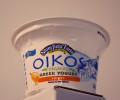How to Make Your Own Greek Yogurt

Culinary Basics Using Greek Yogurt
Part of culinary basics these days is learning to cook with Greek yogurt to create healthy recipes. But wait - you can make your own Greek yogurt and save money.
You can also control what goes into it. You can add flavors if you'd like after it's made. I like mine plain with a few bits of fruit or a sprinkling of nuts and ground flax seed to give it more flavor.
Greek yogurt is a stiffer texture than regular yogurt but Greek yogurt has properties that regular yogurt does not have.
Some of the ‘selling’ points' for Greek yogurt are that it is higher in protein and lower in carbs. It is also thicker and creamier.
Greek yogurt will also withstand stovetop cooking whereas regular yogurt will not due to curdling and separation.
Greek yogurt is not as high in calcium as regular yogurt but it is lower in sodium because of the draining.
Use Greek yogurt to make sauces and dips such as Cucumber Sauce.
Use it in place of sour cream and if a recipe calls for mayonnaise, substitute half of the mayo with Greek yogurt.
You can use Greek yogurt as a substitute in place of buttermilk and cream in muffins, etc. You will get the ‘tartness’ that you wanted from buttermilk and the creaminess from the cream but toss out a lot of fat.
Don’t forget the whey – no whey!
Use the liquid left over from this recipe (yes, whey) - either stir back some of it into the yogurt if you don’t like the stiffness of the final product – or add to soups and stews for a boost in nutrition.
Recipe for Greek Yogurt
This is for unflavored Greek yogurt – add flavorings after it is complete if desired.
INGREDIENTS AND EQUIPMENT
- 1 quart (32 oz) plain yogurt (check fat content – there are 1%, 2% or whole milk plain yogurts as well as other varieties)
- Colander or a large strainer
- Dish towel or tight-weave cheesecloth (if using towel, make sure no scent from detergent or fabric softener as it will flavor the yogurt)
- Large mixing bowl
PREPARATION
- Place strainer or colander over the mixing bowl (you do not want the strainer to rest in the liquid that drains off into the bowl. The colander or strainer needs to be large enough to hold the 32 ounces of yogurt and yet not get into the whey). There should be about a 2-inch gap between the bottom of the strainer and the bottom of the bowl.
- Place a dishtowel or cheesecloth in the strainer. Bear in mind the yogurt should not drain through, just the liquid whey, so the cheesecloth should be close weave. (Use the whey in other recipes as above).
- Pour or spoon the yogurt into the lined colander or strainer. Fold loose ends over the yogurt and cover the yogurt up.
- Place the bowl, colander and draining yogurt into the refrigerator. Drain for at least 3 hours.
- Test for desired thickness – a good indicator is a spoon set in will stand upright. If it gets too thick, you can always thin it out by adding whey back.
- You can also split into batches and thin each separately!
- If it is the thickness that you want, use towel or cheesecloth to roll into container. Use for recipes or eat at this stage.
This is also part of a recipe that prepares the 'cheese' for various cheesecake recipes with a healthier revamp. Yogurt does make an excellent cheesecake!
- Culinary Basics: How to Make Greek Yogurt Cucumber Sauce
Culinary basics is all about learning to use different ingredients for 'standard' recipes. Here is a new and improved version of Cucumber Sauce and is a 'must have' in the quest for healthy recipes. ... - Make your own Greek Yogurt
Just turn on the Food Network and in no time you will see one of those talented chefs using greek-style yogurt for a myriad of recipes ranging from salads to desserts. The thick, creamy consistency of... - Tzatziki (Greek Yogurt Sauce) Recipe
I love Greek and Mediterranean food. I often make falafel and when I do I compliment it with homemade tzatziki sauce. Some people refer to this sauce as yogurt sauce. As with anything else, there are a... - Making Greek Yogurt
To make Greek yogurt, you first need to create some










